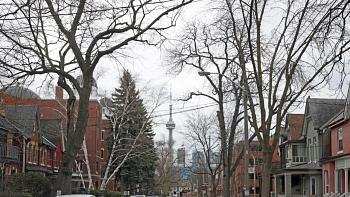Toronto’s housing crisis is costing us all billions. Does city hall care?
We can argue about exactly when Toronto’s housing crisis started, but it seems reasonable at this point to say that we’re in at least the second decade of a shortage of roofs that has forced growing numbers of people to either struggle badly to make a living here or simply leave the province’s largest city altogether — something people are doing by the thousands every year in search of more affordable homes to raise families in.
A new report from the Toronto Region Board of Trade and WoodGreen Community Services tries to put some numbers to the broader costs of the housing crisis in the region. “Broader” costs, because we’re not just talking about the fact that homes are immensely expensive to buy or rent in the GTA. Rather, the report’s authors wanted to try and put some numbers to the drag that high housing costs pose for the regional economy.
The estimate — which TRBT’s Craig Ruttan and WoodGreen’s Michelle German both stress almost certainly doesn’t actually capture the full picture — is that Toronto’s housing crisis is costing the regional economy between $6 billion and $8 billion annually. Most of that estimate comes from two intuitive impacts of the region’s high housing prices: Employers need to pay more to retain workers in Toronto than they would elsewhere in the province. And, in cases where even the GTA wage premium isn’t good enough, workers are decamping to other regions (elsewhere in Ontario or farther afield), hurting the region’s long-term economic picture.
There are more subtle costs, too, such as business costs from higher rates of employee turnover —employers need to train up new workers to replace their departed colleagues. Then there’s time lost to long commutes, as workers have to travel ever-longer distances to make a Toronto wage pay for a mortgage farther down a 400-series highway.
Ruttan says that he hopes the numbers in the report will resonate with the business community and policymakers.
“The innovation economy is all of the sudden captured in the housing debate as well,” Ruttan says. “It doesn’t have to be this way; it’s not something we should just take as a given. We don’t need to be happy with the status quo, because it’s not working.”
If it’s not working for businesses, it’s also manifestly not working for essential workers, including some of the people who’ve been asked to give a lot during the pandemic.
“Why would a nurse work in Toronto when they can be paid the same in Hamilton and pay way less for housing? Why would a teacher work in downtown Toronto when they can move to Caledon and have a much easier go at their day-to-day life?” German asks. “How do we make sure the city we’re building is appropriate — the right size, the right location, and the right price for the people who hold us together?”
This most recent report is the third in a series from the Board of Trade and Woodgreen; collectively, they lay out the case that Toronto needs to fix its housing policies or risk continuing to price out an entire cohort of essential workers that the city depends on to run. Recent events at Toronto city council raise the bleak but unavoidable question: Does anyone in a position to change things actually care?
The evidence from last week isn’t grounds for optimism. Council briefly considered an item to legalize and regulate rooming houses citywide, an issue that has consumed months of work from city staff and represents the only reasonable path forward for the city — but Mayor John Tory had to punt the issue to later in the political calendar because he didn’t have a majority of councillors onside. It might simply die until after the next municipal election, but even if something does pass, it’s likely to have been made worse thanks to the negotiations needed to win over recalcitrant councillors.




